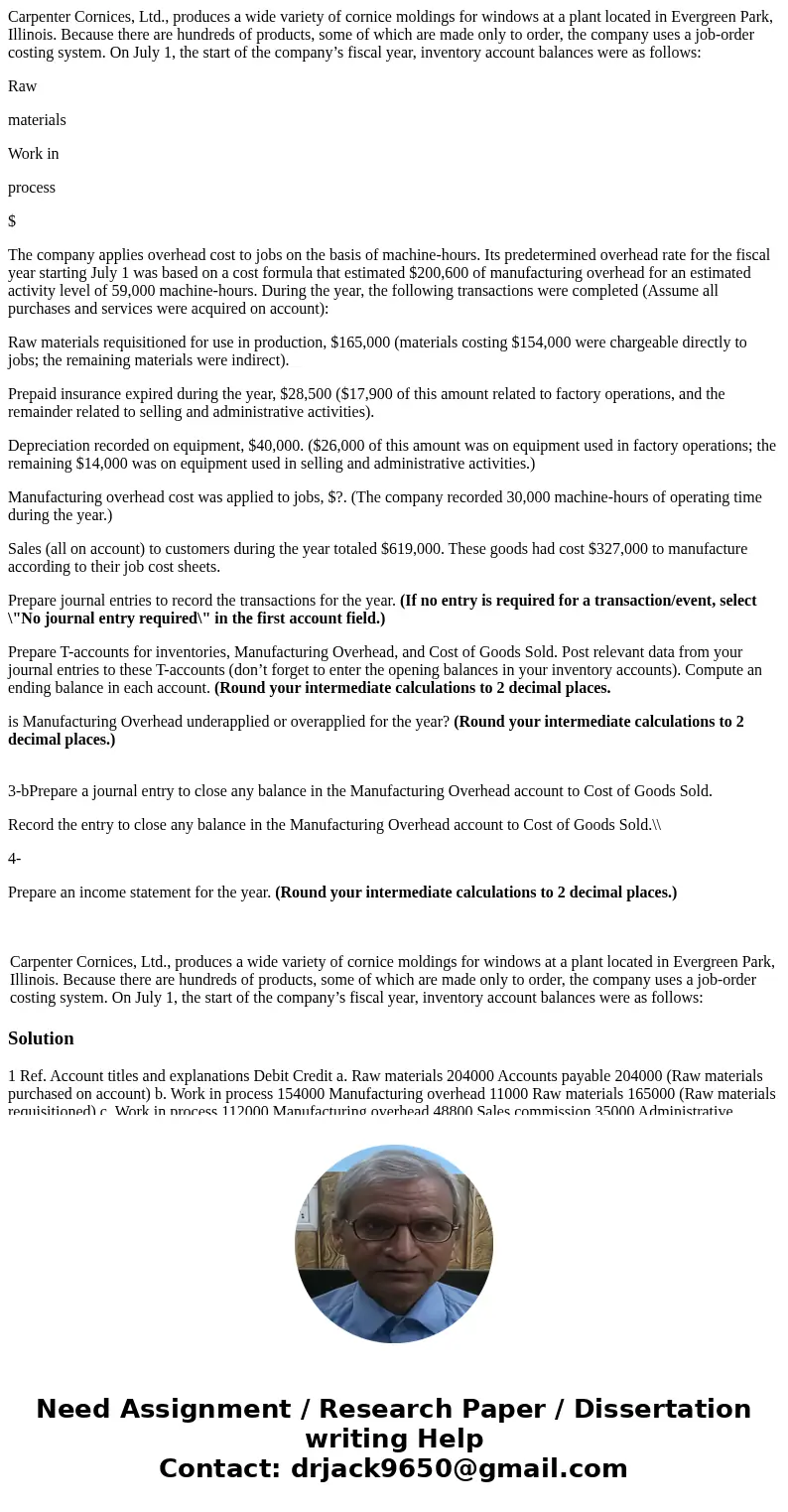Carpenter Cornices Ltd produces a wide variety of cornice mo
Carpenter Cornices, Ltd., produces a wide variety of cornice moldings for windows at a plant located in Evergreen Park, Illinois. Because there are hundreds of products, some of which are made only to order, the company uses a job-order costing system. On July 1, the start of the company’s fiscal year, inventory account balances were as follows:
Raw
materials
Work in
process
$
The company applies overhead cost to jobs on the basis of machine-hours. Its predetermined overhead rate for the fiscal year starting July 1 was based on a cost formula that estimated $200,600 of manufacturing overhead for an estimated activity level of 59,000 machine-hours. During the year, the following transactions were completed (Assume all purchases and services were acquired on account):
Raw materials requisitioned for use in production, $165,000 (materials costing $154,000 were chargeable directly to jobs; the remaining materials were indirect).
Prepaid insurance expired during the year, $28,500 ($17,900 of this amount related to factory operations, and the remainder related to selling and administrative activities).
Depreciation recorded on equipment, $40,000. ($26,000 of this amount was on equipment used in factory operations; the remaining $14,000 was on equipment used in selling and administrative activities.)
Manufacturing overhead cost was applied to jobs, $?. (The company recorded 30,000 machine-hours of operating time during the year.)
Sales (all on account) to customers during the year totaled $619,000. These goods had cost $327,000 to manufacture according to their job cost sheets.
Prepare journal entries to record the transactions for the year. (If no entry is required for a transaction/event, select \"No journal entry required\" in the first account field.)
Prepare T-accounts for inventories, Manufacturing Overhead, and Cost of Goods Sold. Post relevant data from your journal entries to these T-accounts (don’t forget to enter the opening balances in your inventory accounts). Compute an ending balance in each account. (Round your intermediate calculations to 2 decimal places.
is Manufacturing Overhead underapplied or overapplied for the year? (Round your intermediate calculations to 2 decimal places.)
3-bPrepare a journal entry to close any balance in the Manufacturing Overhead account to Cost of Goods Sold.
Record the entry to close any balance in the Manufacturing Overhead account to Cost of Goods Sold.\\
4-
Prepare an income statement for the year. (Round your intermediate calculations to 2 decimal places.)
| Carpenter Cornices, Ltd., produces a wide variety of cornice moldings for windows at a plant located in Evergreen Park, Illinois. Because there are hundreds of products, some of which are made only to order, the company uses a job-order costing system. On July 1, the start of the company’s fiscal year, inventory account balances were as follows: |
Solution
1 Ref. Account titles and explanations Debit Credit a. Raw materials 204000 Accounts payable 204000 (Raw materials purchased on account) b. Work in process 154000 Manufacturing overhead 11000 Raw materials 165000 (Raw materials requisitioned) c. Work in process 112000 Manufacturing overhead 48800 Sales commission 35000 Administrative salaries 54000 Salaries and wages payable 249800 (Costs for employee services were incurred) d. Manufacturing overhead 17900 Insurance expense 10600 Prepaid insurance 28500 (Prepaid insurance expired during the year) e. Manufacturing overhead 26000 Accounts payable 26000 (Utility costs incurred) f. Advertising expense 15000 Accounts payable 15000 (Advertising costs incurred) g. Manufacturing overhead 26000 Depreciation expense 14000 Accumulated depreciation 40000 (Depreciation recorded on equipment) h. Work in process (Note:1) 102000 Manufacturing overhead 102000 (Manufacturing overhead cost was applied to jobs) i. Finished goods 328000 Work in process 328000 (Goods that had cost $328,000 to manufacture according to their job cost sheets were completed.) j. Accounts receivable 619000 Sales 619000 (Sales to customers during the year) Cost of goods sold 327000 Finished goods 327000 (These goods had cost $327,000 to manufacture according to their job cost sheets.) Notes: 1. Pre-determined overhead rate=Estimated manufacturing overhead/Estimated activity level=200600/59000=$3.4 per hour Applied overhead=Actual machine hours*pre-determined overhead rate=30000*3.4=102000 2 Raw material Beg. Bal 12800 Accounts payable 204000 Work in process 154000 Manufacturing overhead 11000 216800 165000 End. Bal 51800 Work in process Beg. Bal 6800 Raw materials 154000 Salaries and wages payable 112000 Manufacturing overhead 102000 Finished goods 328000 374800 328000 End. Bal 46800 Finished goods Beg. Bal 10500 Work in process 328000 Cost of goods sold 327000 338500 327000 End. Bal 11500 Manufacturing overhead Raw materials 11000 Salaries and wages payable 48800 Prepaid insurance 17900 Accounts payable 26000 Accumulated depreciation 26000 Work in process 102000 129700 102000 End. Bal 27700 Cost of goods sold Finished goods 327000 327000 0 End. Bal 327000 3-a. Actual manufacturing overhead=$129700 Applied iverhead=$102000 Under applied overhead=129700-102000=27700 3-b. Debit Credit Cost of goods sold 27700 Manufacturing overhead 27700 4 Income statement Sales 619000 Less: Cost of goods sold (327000+27700) 354700 Gross margin 264300 Less: Operating expenses Sales commission 35000 Administrative salaries 54000 Insurance expense 10600 Advertising expense 15000 Depreciation expense 14000 128600 Net income 135700

 Homework Sourse
Homework Sourse